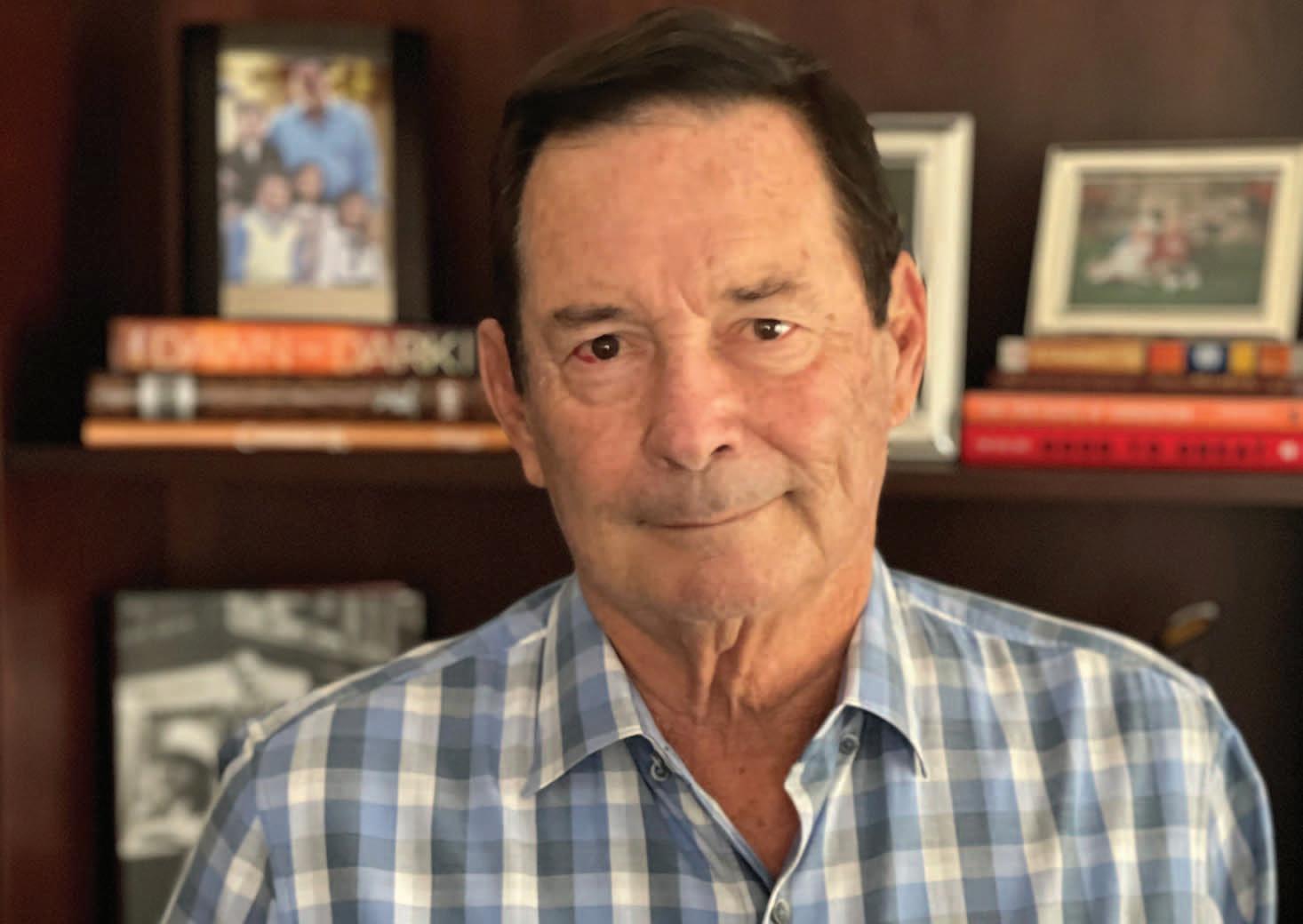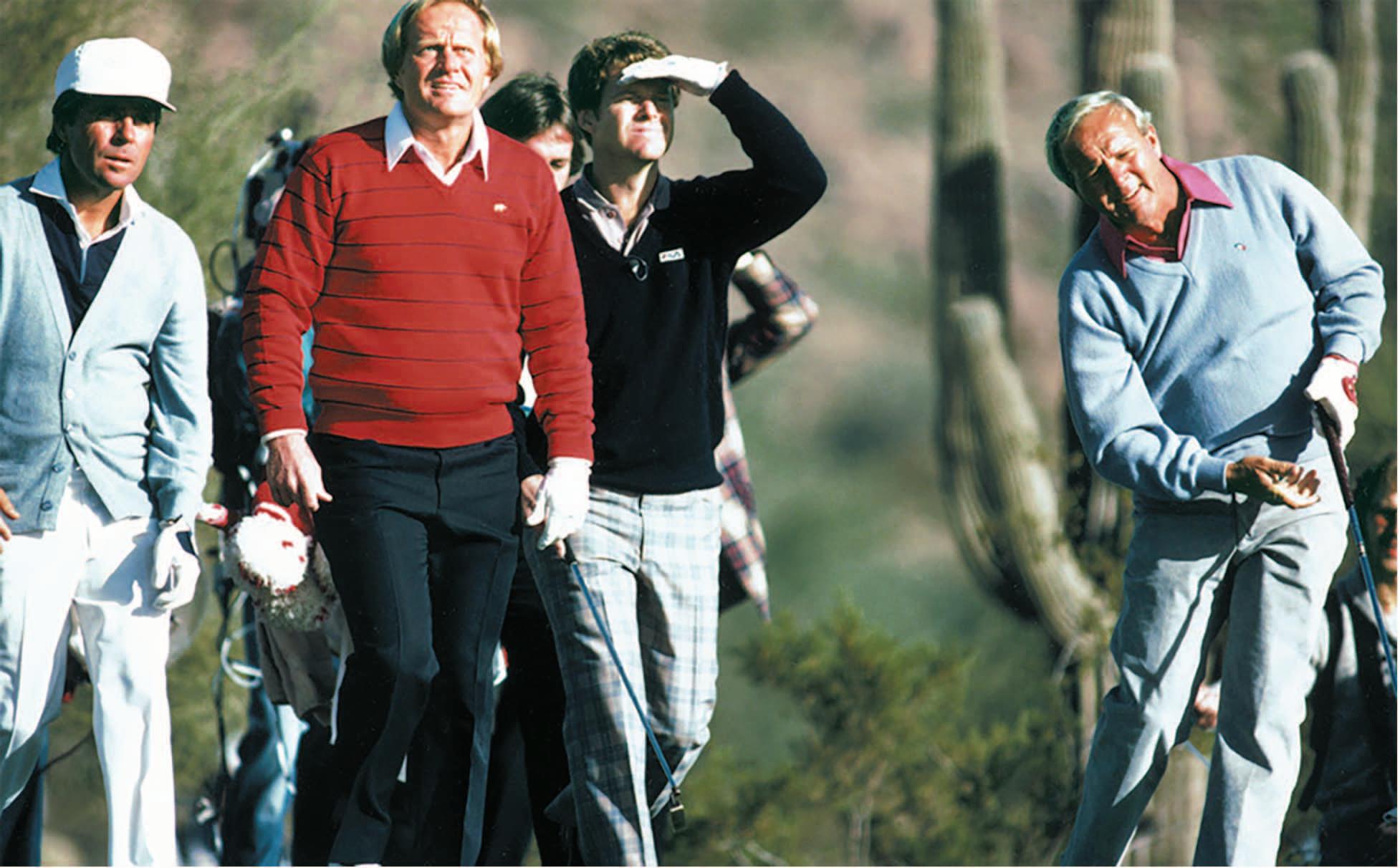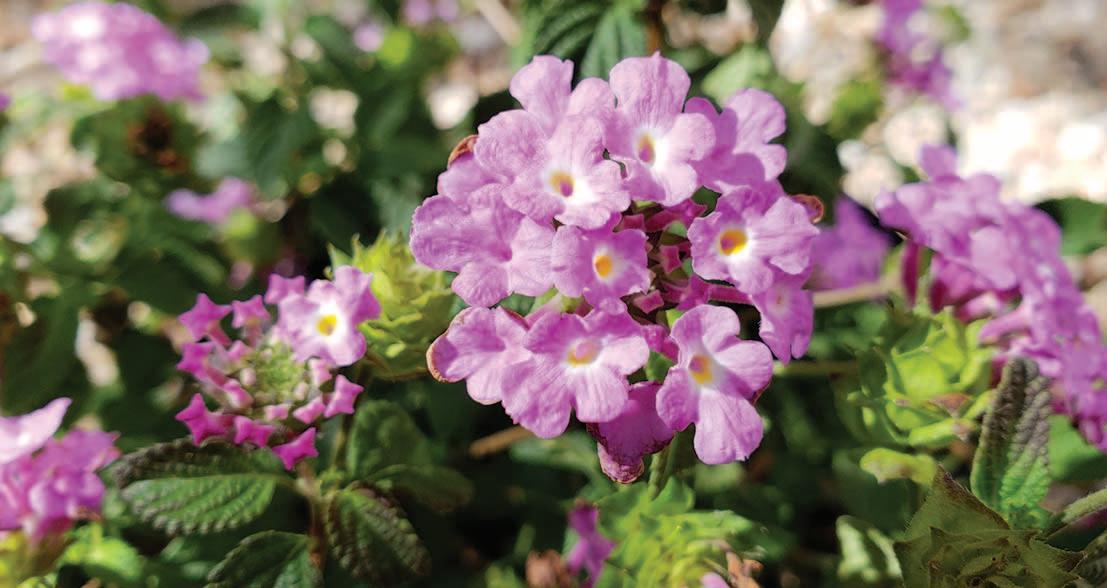
10 minute read
Lyle Anderson and the Early Years at Desert Mountain
Ron Helm
Damon DiOrio, CEO of the Desert Mountain Club, introduced me to Lyle Anderson, the legendary luxury golf community developer. Lyle transformed the desert of Scottsdale into a worldrenowned luxury golf area with several topranked communities, including Desert Mountain. He is currently working on his new visions for luxury estates in Hawaii and Mexico. These new Lyle Anderson masterpieces are rare, oneofakind properties that incorporate his signature integration of environmental and architectural design.
I had the honor to sit down with the man that Golf Week called, “the man largely responsible for shaping Scottsdale into one of America’s most desirable addresses.”
When Lyle was growing up in Washington, his family’s 9hole golf course in Seattle flooded, financially ruining his family. “Our family was on Red Cross … and struggled like everyone else during these times”. Like so many other entrepreneurs, the deepest passions often come from childhood experiences seeking to reverse the misfortunes of our family. For Lyle, that inner passion would soon emerge.
He graduated from the University of Washington with an Electrical Engineering degree. He recalls, “I realized that I wanted to be free and not work for another company. I would rather own my own business, even if it was a candy store.” He met the real estate professional working on a project on the Olympic Peninsula and was hired for weekend sales. Eventually, he was hired as a fulltime sales manager. To Lyle, it was always about freedom. He says that he truly has never worked because he thoroughly enjoys what he does, although it was not always easy. Lyle began syndicating land deals with groups of investors. “I started to buy land for investment groups and had good success.” When the Northwest economy turned south, Lyle searched for new areas to work and fell in love with Arizona.
Desert Highlands
In 1980, “the 800-acre Desert Highlands property was one of the first pieces I bought on my own. I just bought it as an investment: to hold it and to resell it.” But one day while playing golf with a friend, Lyle said, “Well, wait a minute, I might do a golf course”. Desert Highlands was far from town and people said they couldn’t believe anyone would go there to live and golf at that time.
Lyle’s vision in the early 1980s was based on his belief that people really didn’t know what they could have. “People wanted to be a member of a private club, they were aspiring for some privacy and the beautiful desert where homes and the golf courses were folded into the environment and not just bulldozed flat lots.” Lyle sold golf memberships with property, which allowed
residents to become equal members without the long waits that other exclusive clubs required.
Lyle’s plan was to build the golf course as the marketing tool for selling Desert Highlands residential lots. Jack Nicklaus had recently begun designing golf courses, and Lyle coldcalled him to help his dream become a reality. “I told myself that if I’m going sell this dream, I’ll need some help. So, I called Jack.” He signed Jack Nicklaus to design and promote the course and developed a great business and personal relationship that began in 1980. Anderson and Nicklaus went on to develop and design other prestigious golf courses in Arizona (such as Desert Mountain), New Mexico, Hawaii and Scotland.
To promote Desert Highlands real estate, Jack told Lyle, “I got this proposal for the Skins Game in Hawaii”. Jack, the biggest star on the professional golf tour, convinced the promoter to move the game to Desert Highlands, honoring his contract with Lyle. Once the promoter saw the course, Lyle said he loved it. Together they created the Skins Game at Desert Highlands to promote the development, which brought together Nicklaus, Arnold Palmer, Gary Player and Tom Watson. The Skins Game immediately jumped to the top of the television ratings. In Lyle’s office there’s a picture of Jack sinking a putt to win $240,000 in the second year the event was held at Desert Highlands – an unheard of amount for that time. Desert Highlands was a huge success, and Lyle began looking for other properties.
Desert Mountain and the Renegade Golf Course
Lyle first visited the Desert Mountain area in the early 1980s. It had been a working cattle spread called Carefree Ranch. At that time, it was owned by Roy Andy Dye, the brother of the famous golf architect Pete Dye. Roy typically worked with his brother designing courses but occasionally took on his own projects. At the Carefree Ranch property Roy built 18 holes in the general area of today’s Renegade course. When Lyle first saw it, the course was in rough shape, with nine holes lost back to the environment. Lyle and Jack tried to keep several original holes, but they were too difficult to save in relationship to the planned development, which was originally a couple thousand acres in the area of the Renegade course.
When Lyle was at St. Andrews Golf Club for the British Open, he got the idea for having two flags at the Renegade course. “I was literally walking through the thick crowds and saw two flags. It got into my head. Why not an easier flag and a harder flag?” He went back to his room and designed a few holes. He had dinner with Jack that night and told him his idea. Jack jokingly said, “I thought you were crazy, but now I know you are crazy”.
The first day Jack and Lyle visited the proposed area of the Renegade course, Jack said, “You know that crazy idea you had in Scotland? Did you really want to do it?” Lyle replied, “If you do, I want to.” Jack bought into the concept, and told Lyle, “Let’s do it. If it turns out that people like it, it’s my idea. If they don’t like it, it’ll be your idea.” This is how good friends treat each other, and Lyle and Jack were like family. Lyle and Jack never had more fun together than designing Renegade course, which opened in 1987.
Relationship with the Great Jack Nicklaus
Jack and Lyle played the AT&T Tournament at the Monterey Peninsula for the last four years of Jack’s career in front of huge galleries. It’s some of his fondest memories with Jack. The first year, he recalled arriving at the airport to meet Jack. Jack grabbed Lyle’s bag and took his driver and refused to give it back to him, telling him to stay on the fairway. In those four years of playing the AT&T, Lyle never used a driver. In addition, as Lyle was single at that time, Jack told Lyle, “No carousing and no drinking”, which Lyle happily agreed to do so he could continued next page L
LYLE ANDERSON, continued
play with Jack. Lyle said “Jack was a true professional and all business but a delight to play with”. He recalled one hole where they both hit drives within 5 feet of each other (although from different tee boxes). They both had side hill lies in wet conditions and into the wind. Lyle (a 4handicap at that time) said, “Jack, do you think the gallery has any idea how hard this shot is?” Jack looked at Lyle and said, “Lyle, they expect me to hit the green”, and Jack rarely disappointed his fans, hitting his shot close the pin. Lyle’s 2iron landed in a greenside sand trap.
Desert Mountain Expansion: Cochise and Geronimo Golf Courses
Lyle’s second major purchase of land at Desert Mountain was several thousand acres in the area of the Cochise and Geronimo courses. Although concerned about mountain lions, Lyle explored the area to the north of the Renegade course area by foot, and thought he saw something special. Although Roy Dye told Lyle, “You can’t build a course out there,” Lyle made the second major purchase in about 1985. After a Skins Game, Lyle and Jack flew by helicopter and landed in the general area of the now existing Cochise Geronimo Clubhouse. After briefly walking around, Jack and Lyle looked at each other and both said, “this could be one of the greatest golf sites ever”. The Cochise and Geronimo courses opened in 1988 and 1989, respectively.
Conservation Pioneer
Lyle also is recognized for his environmental conservation measures, which were subsequently adopted by the City of Scottsdale. He developed the technique of watering into fairways and not into the desert, creating the tight fairway concept that is now famous for desert golf, which explains why he has been called “The Father of Desert Golf”. He also tried to save the natural landscape and desert plants to the extent practical. He said, “It’s far more expensive to develop that way, but look at the result.”
Anderson’s successes in the north effectively allowed other developers to backfill closer to town with new private developments. And, as Anderson moved northward, the City of Scottsdale followed him, annexing land including Desert Highlands and Desert Mountain. Because of his influences on the City of Scottsdale, he was elected to their Hall of Fame in 2003.
National Recognition
Anderson’s seemingly risky formula to build golf courses before homes – opposite of most other developers – continued at Desert Mountain. In the late 1980s, Anderson approached the PGA golf commissioner Dean Beman at the Phoenix Open and said, “Dean, I would really like to do a golf tournament in spring.” Dean was concerned about having two PGA events in proximity to each other. He recommended something else, “Lyle, you could have the best tournament on the Senior’s Tour.” Lyle bought into the idea and created The Tradition (1989 to 2001), which was played on the Cochise course. It showcased target golf played on a dramatic desert landscape and served as a powerful marketing campaign for the upscale lifestyle of Desert Mountain. After its fourth year, the PGA Tour recognized the event as one of the five senior major golf championships. The Tradition promoted the whole Scottsdale area as a secondhome market and a wonderful place to retire.
Desert Mountain: The Early Years
Desert Mountain was officially established in 1986. Originally, it was zoned for 6,000 homes and five hotels. Lyle realized that he had to “flow with the market”. Lyle believed that this land was better suited as a luxury golf community. To achieve rigid
LYLE ANDERSON, continued
$125,000. Lyle continued to use Jack for promotions because “people wanted to meet him.” When Jack played the opening round at the Renegade course, they had 50 sales that day. Eventually, Anderson began building spec homes (moveinready homes) for sale in the early 1990s; he built approximately 600 homes in villages such as Cochise Ridge. Due to the size of the development, Anderson and Taliesin created the village The Skins Game at Desert Highland: concept to provide better (left to right) Gary Player, Jack Nicklaus, Tom Watson, Arnold Palmer security and to promote their own neighborhood identity. design guidelines that ensured each home and The villages were accessed off the main “spine road”, building materials would blend with the high Desert Mountain Parkway. Sonoran Desert, Lyle hired Taliesinassociated architects as the Master Designers. Taliesin was an The Trails architectural firm founded by Frank Lloyd Wright to Finally, I asked Lyle about our trail system. I carry on his architectural vision after his death in mentioned that in 2020, there were over 26,500 1959. It was headquartered at Taliesin West in hikes taken on the Desert Mountain private trails. Scottsdale and had up to 14 principals who had all Lyle leaned back with a smile and said, “I think we saw worked under Wright. Taliesin and Anderson the potential, but I knew it would take time. As a required “development as sensitively as we could”, developer, you set a community into motion and then creating building envelopes and preserving at least you have to let it go. I take my hat off to the members half the lot for native desert. The Master Association and what they have done with the trails.” still uses many of the Taliesin guidelines today, although they have evolved with time. When you consider the odds against developing a community the size of Desert Mountain so far Originally, each lot sold came with a membership removed from Scottsdale, this development plus the adjacent lot with another membership, must be his greatest achievement. Although there allowing the owner to sell the second lot with a were difficulties along the way, they were solved, membership later if desired. These Charter Members and our wonderful community was created. We also had free dues until the year 2000. The original have Lyle Anderson to thank for his great vision selling price of a typical lot was approximately and perseverance.











